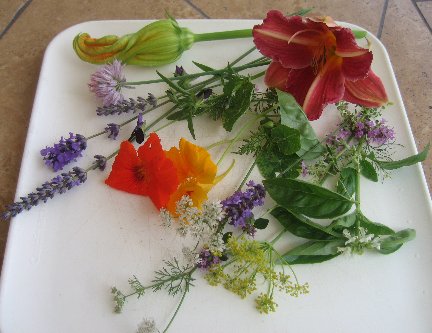Chinese Perfume Plant, Queensland Silver Wattle, Cloves, Chinese Lotus, Blue Lotus, Screwpine, Turpentine Tree, Sweet Autum Clematis, St. Anthony’s Turnip, Quince
Above, edible flowers by Leggiadro.com
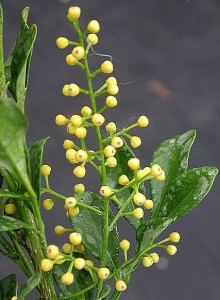
Until I get more ambitious or there buds a blossoming fragrant hue for more, I will end this series at 20 articles, or 200 flowers. I still have to add two separate large articles but that will have to wait some wordpress issues and file sizes are resolved.
Among all the flowers in the world the one touted as the most exquisitely scented is Agalia odorata, the Chinese Perfume Plant. Think vanilla with spicy undertones. Bright yellow, the blossoms are dried and used for scenting tea. However, the leaves are also edible, steamed as a vegetable. Native to southern China it can be found in flower gardens about the globe. While you can’t tell it in this picture the blossom are about the size of BBs. Sometimes the flower is called Mock Lime, or Juran. It can be a year round plant in zones 9 and 10. Otherwise, in a pot it goes.
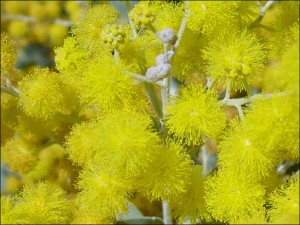 There are several edible Acacia blossoms and several Acacia with other edible parts. Featured here is Acacia podalyriaefolia, or the Queensland Silver Wattle. The blossoms can be mixed in a light batter similar to elder flowers and fried into small fritters. They are often served with sugar and whipped cream. Other Acacia with edible blossoms include A. spectabilis and A. oshanessii. While a native to Australia it is naturalized in Malaysia, Africa, India and South America. It is also used as an ornamental tree in other areas.
There are several edible Acacia blossoms and several Acacia with other edible parts. Featured here is Acacia podalyriaefolia, or the Queensland Silver Wattle. The blossoms can be mixed in a light batter similar to elder flowers and fried into small fritters. They are often served with sugar and whipped cream. Other Acacia with edible blossoms include A. spectabilis and A. oshanessii. While a native to Australia it is naturalized in Malaysia, Africa, India and South America. It is also used as an ornamental tree in other areas.
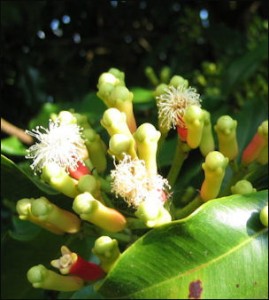 The flower buds of the Syzygium aromaticum is your common clove, dried. They are used for seasoning with ham, sausages, apples, mincemeat, cheese, pies, preserves, and vermouth. In some places cloves are chewed after dinner like a mint. The oil is used to flavor gum, beverages, ice cream, baked goods, and candies. What most folks don’t know is the tree’s fruit is edible as are its dried flowers. A close relative S. malaccense, has edible flowers as well as young shoots and leaves.
The flower buds of the Syzygium aromaticum is your common clove, dried. They are used for seasoning with ham, sausages, apples, mincemeat, cheese, pies, preserves, and vermouth. In some places cloves are chewed after dinner like a mint. The oil is used to flavor gum, beverages, ice cream, baked goods, and candies. What most folks don’t know is the tree’s fruit is edible as are its dried flowers. A close relative S. malaccense, has edible flowers as well as young shoots and leaves.
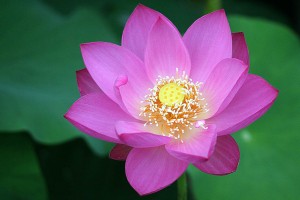 One cannot write about edible flowers without mentioning the Lotus, Nelumbo nucifera, also called Pink Lotus, Chinese Lotus, and Lin ngau. This is the plant that produces the famous roots in so many Asian dishes. Its roots can be boiled, pickled, stir-fried even preserved in sugar. The seeds are also eaten raw, roasted, boiled, pickled or candied. What a lot of foraging books don’t tell you is 1) the roots are really labor intensive to dig up, and 2) the blossoms are edible. The petals are used as garnishes or are floated in soups.
One cannot write about edible flowers without mentioning the Lotus, Nelumbo nucifera, also called Pink Lotus, Chinese Lotus, and Lin ngau. This is the plant that produces the famous roots in so many Asian dishes. Its roots can be boiled, pickled, stir-fried even preserved in sugar. The seeds are also eaten raw, roasted, boiled, pickled or candied. What a lot of foraging books don’t tell you is 1) the roots are really labor intensive to dig up, and 2) the blossoms are edible. The petals are used as garnishes or are floated in soups.
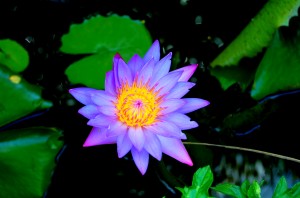 Closely related to the lotus is Nymphaea stellata, also called the Blue Lotus of India. That it can be white shall be overlooked for now. Its roots are sometimes eaten raw or roasted. The seeds are edible as well, usually parched. The flowers are edible. And as so often the case, botanists cannot leave the name alone. The Blue Lotus of India is also known as Nymphaea nouchali. Now, doesn’t that make more sense?
Closely related to the lotus is Nymphaea stellata, also called the Blue Lotus of India. That it can be white shall be overlooked for now. Its roots are sometimes eaten raw or roasted. The seeds are edible as well, usually parched. The flowers are edible. And as so often the case, botanists cannot leave the name alone. The Blue Lotus of India is also known as Nymphaea nouchali. Now, doesn’t that make more sense?
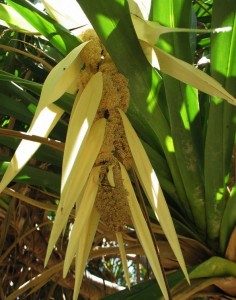 I can’t remember if it was Ray Mears or Les Hiddins who first brought my attention to the Pandanus, or in this particular case Pandanus tectorius. The Pandanus is a palm. It’s also called the Nicobar Breadfruit and Screwpine. The fruit pulp can be eaten raw or cooked or made into a flour. It’s also used to make a local alcoholic drink. Young leaves are eaten as are the aerial roots, terminal bud and seeds. The flowers and pollen are edible as well. Native from Malaysia to Polynesia, it is an ornamental in warmer areas elsewhere. I’m reasonably sure there is a stand of them growing in Dreher Park, West Palm Beach. Fl., but I haven’t sorted out which species it is.
I can’t remember if it was Ray Mears or Les Hiddins who first brought my attention to the Pandanus, or in this particular case Pandanus tectorius. The Pandanus is a palm. It’s also called the Nicobar Breadfruit and Screwpine. The fruit pulp can be eaten raw or cooked or made into a flour. It’s also used to make a local alcoholic drink. Young leaves are eaten as are the aerial roots, terminal bud and seeds. The flowers and pollen are edible as well. Native from Malaysia to Polynesia, it is an ornamental in warmer areas elsewhere. I’m reasonably sure there is a stand of them growing in Dreher Park, West Palm Beach. Fl., but I haven’t sorted out which species it is.
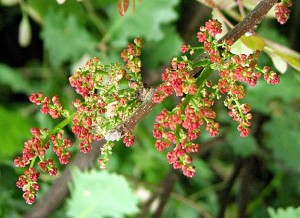 The name Turpentine tree, Pistacia terebinthus, does not sound too edible. Perhaps it all depends upon where you live and how hungry you are. Actually it has an esteemed relative we eat all the time. Native to the Mediterranean region, the turpentine tree is in the same genus as the Pistachio. Its green seed kernals are eaten or pressed for their oil. The immature fruits are preserved, usually in vinegar and salt, and used as a relish. Young leaves are cooked and used as a vegetable. The sap is used to make a chewing gum and the fresh flowers are edible raw. Some caution should be used as this tree, like pistachios, is closely related to poison ivy/oak and poison sumac, along with cashews and mangos. Many people are allergic to the entire group.
The name Turpentine tree, Pistacia terebinthus, does not sound too edible. Perhaps it all depends upon where you live and how hungry you are. Actually it has an esteemed relative we eat all the time. Native to the Mediterranean region, the turpentine tree is in the same genus as the Pistachio. Its green seed kernals are eaten or pressed for their oil. The immature fruits are preserved, usually in vinegar and salt, and used as a relish. Young leaves are cooked and used as a vegetable. The sap is used to make a chewing gum and the fresh flowers are edible raw. Some caution should be used as this tree, like pistachios, is closely related to poison ivy/oak and poison sumac, along with cashews and mangos. Many people are allergic to the entire group.
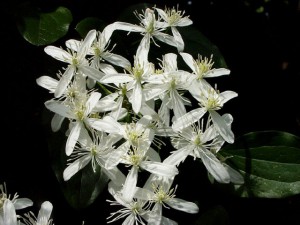 Attractive ornamentals are often toxic but not the Clematis maximowicziana, or Sweet Autumn Clematis, a popular vine among gardeners in North America. What I find interesting is how often English or country garden sites often just lable every plant they grow as poisonous. It must just come with the mind set. The Sweet Autumn Clematis is definitely edible. Young leaves are parboiled then are boiled or stir fried. Young buds are used the same way or pickled. The flowers are also edible. Yet like so many internet sites that copy each other one says for them all: All parts of plant are poisonous if ingested. Perhaps if eaten raw they are. Cooked they are not which is good as this is a popular garden specimen.
Attractive ornamentals are often toxic but not the Clematis maximowicziana, or Sweet Autumn Clematis, a popular vine among gardeners in North America. What I find interesting is how often English or country garden sites often just lable every plant they grow as poisonous. It must just come with the mind set. The Sweet Autumn Clematis is definitely edible. Young leaves are parboiled then are boiled or stir fried. Young buds are used the same way or pickled. The flowers are also edible. Yet like so many internet sites that copy each other one says for them all: All parts of plant are poisonous if ingested. Perhaps if eaten raw they are. Cooked they are not which is good as this is a popular garden specimen.
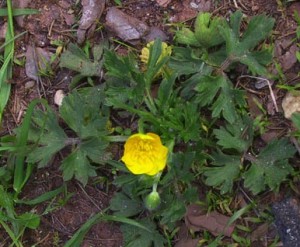 Buttercups are usually a family foragers stay away from. It was one of the few flowers I was told as a kid that were poisonous that really are. They grew in a damp spot right behind the house. But not every one in the family will make you ill. Among the edible members is Ranunculus bulbosus, also called St. Anthony’s Turnip. I don’t know if that is a compliment to St. Anthony or not. Caution is recommended as the plant can have a strong, acrid juice that can cause blistering. Bulbs of the plant are eaten after boiling or thorough drying. The young flowers are pickled. In North America the plant is found in the eastern US except for Florida, and also growing along the west coast. It skips Texas north, the high plains, Rocky Mountains and desert southwest.
Buttercups are usually a family foragers stay away from. It was one of the few flowers I was told as a kid that were poisonous that really are. They grew in a damp spot right behind the house. But not every one in the family will make you ill. Among the edible members is Ranunculus bulbosus, also called St. Anthony’s Turnip. I don’t know if that is a compliment to St. Anthony or not. Caution is recommended as the plant can have a strong, acrid juice that can cause blistering. Bulbs of the plant are eaten after boiling or thorough drying. The young flowers are pickled. In North America the plant is found in the eastern US except for Florida, and also growing along the west coast. It skips Texas north, the high plains, Rocky Mountains and desert southwest.
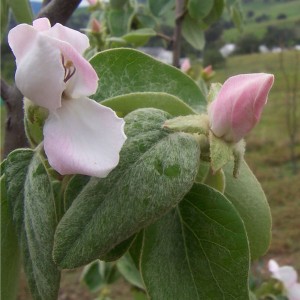 The 200th edible flower in this series is the Quince, one of my mother’s favorites, Cydonia oblonga. She has a flowering Quince right outside her front door and delights in watching birds nest in it. She also likes to complain about its thorns. Quince used to be a common fruit a century ago but needed to be prepared. Even the great botanist Luther Burbank said before he began breeding better cultivars to make them more edible, “take one quince, and barrel of sugar and sufficient water…” While quinces have fallen out of favor in the United States they are still popular elsewhere particularly in the Mediterranean region. The fruits are cooked, stewed, used in pies, jams or marmalades, fruit leather, candies and conserves. The flowers are also edible and in some places the leaves are used to wrap food like Greek dolmas.
The 200th edible flower in this series is the Quince, one of my mother’s favorites, Cydonia oblonga. She has a flowering Quince right outside her front door and delights in watching birds nest in it. She also likes to complain about its thorns. Quince used to be a common fruit a century ago but needed to be prepared. Even the great botanist Luther Burbank said before he began breeding better cultivars to make them more edible, “take one quince, and barrel of sugar and sufficient water…” While quinces have fallen out of favor in the United States they are still popular elsewhere particularly in the Mediterranean region. The fruits are cooked, stewed, used in pies, jams or marmalades, fruit leather, candies and conserves. The flowers are also edible and in some places the leaves are used to wrap food like Greek dolmas.
asdfdfsdf

